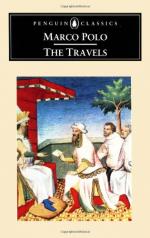NOTE 3.—Marco is not the only eminent person who has expressed this view of Sakyamuni’s life in such words. Professor Max Mueller (u.s.) says: “And whatever we may think of the sanctity of saints, let those who doubt the right of Buddha to a place among them, read the story of his life as it is told in the Buddhistic canon. If he lived the life which is there described, few saints have a better claim to the title than Buddha; and no one either in the Greek or the Roman Church need be ashamed of having paid to his memory the honour that was intended for St. Josaphat, the prince, the hermit, and the saint.”
NOTE 4.—This is curiously like a passage in the Wisdom of Solomon: “Neque enim erant (idola) ab initio, neque erunt in perpetuum ... acerbo enim luctu dolens pater cito sibi rapti filii fecit imaginem: et ilium qui tune quasi homo mortuus fuerat nunc tamquam deum colere coepit, et constituit inter servos suos sacra et sacrificia” (xiv. 13-15). Gower alludes to the same story; I know not whence taken:—
“Of Cirophanes, seith the
booke,
That he for sorow, whiche he toke
Of that he sigh his sonne dede,
Of comfort knewe none other rede,
But lete do make in remembrance
A faire image of his semblance,
And set it in the market place:
Whiche openly to fore his face
Stood euery day, to done hym ease;
And thei that than wolden please
The Fader, shuld it obeye,
Whan that thei comen thilke weye.”
—Confessio
Amantis.[8]
NOTE 5.—Adam’s Peak has for ages been a place of pilgrimage to Buddhists, Hindus, and Mahomedans, and appears still to be so. Ibn Batuta says the Mussulman pilgrimage was instituted in the 10th century. The book on the history of the Mussulmans in Malabar, called Tohfat-ul-Majahidin (p. 48), ascribes their first settlement in that country to a party of pilgrims returning from Adam’s Peak. Marignolli, on his visit to the mountain, mentions “another pilgrim, a Saracen of Spain; for many go on pilgrimage to Adam.”
The identification of Adam with objects of Indian worship occurs in various forms. Tod tells how an old Rajput Chief, as they stood before a famous temple of Mahadeo near Udipur, invited him to enter and worship “Father Adam.” Another traveller relates how Brahmans of Bagesar on the Sarju identified Mahadeo and Parvati with Adam and Eve. A Malay MS., treating of the origines of Java, represents Brahma, Mahadeo, and Vishnu to be descendants of Adam through Seth. And in a Malay paraphrase of the Ramayana, Nabi Adam takes the place of Vishnu. (Tod. I. 96; J.A.S.B. XVI. 233; J.R.A.S. N.S. II. 102; J. Asiat. IV. s. VII. 438.)




